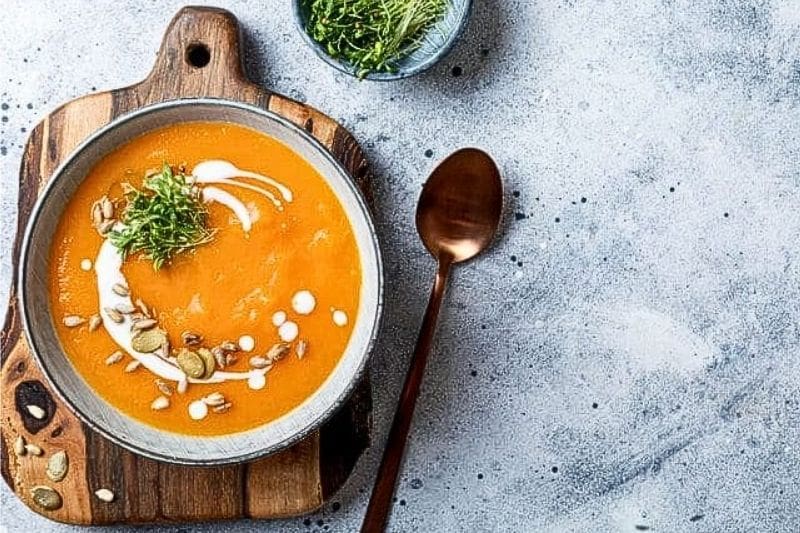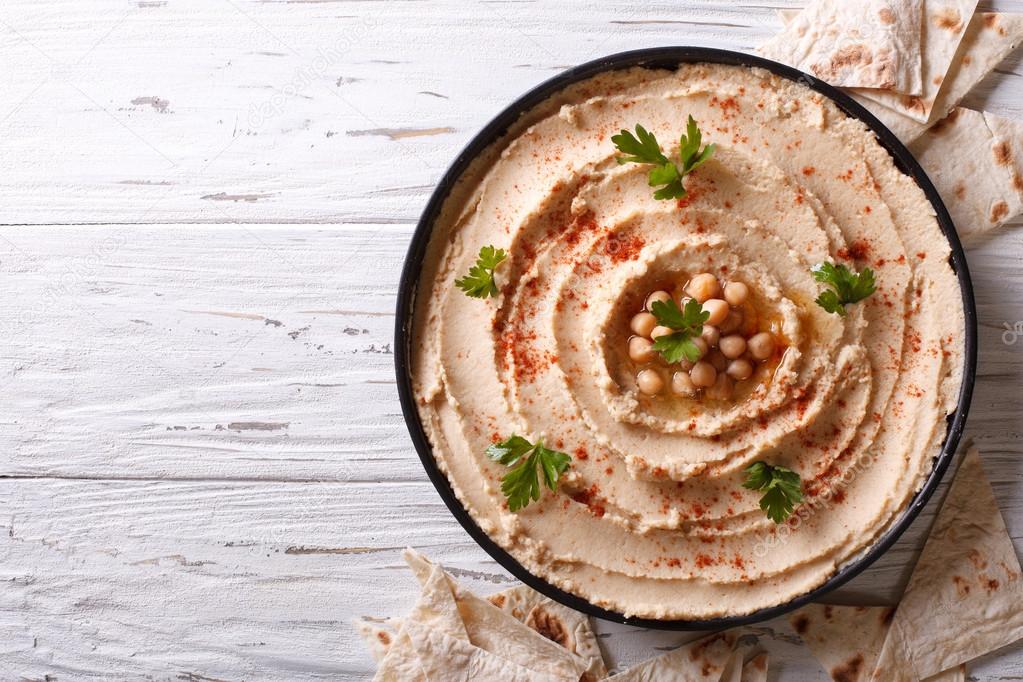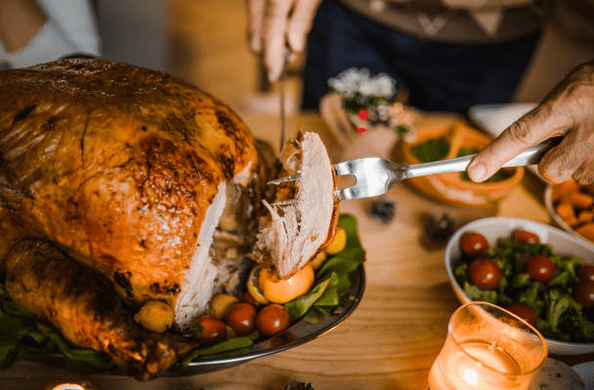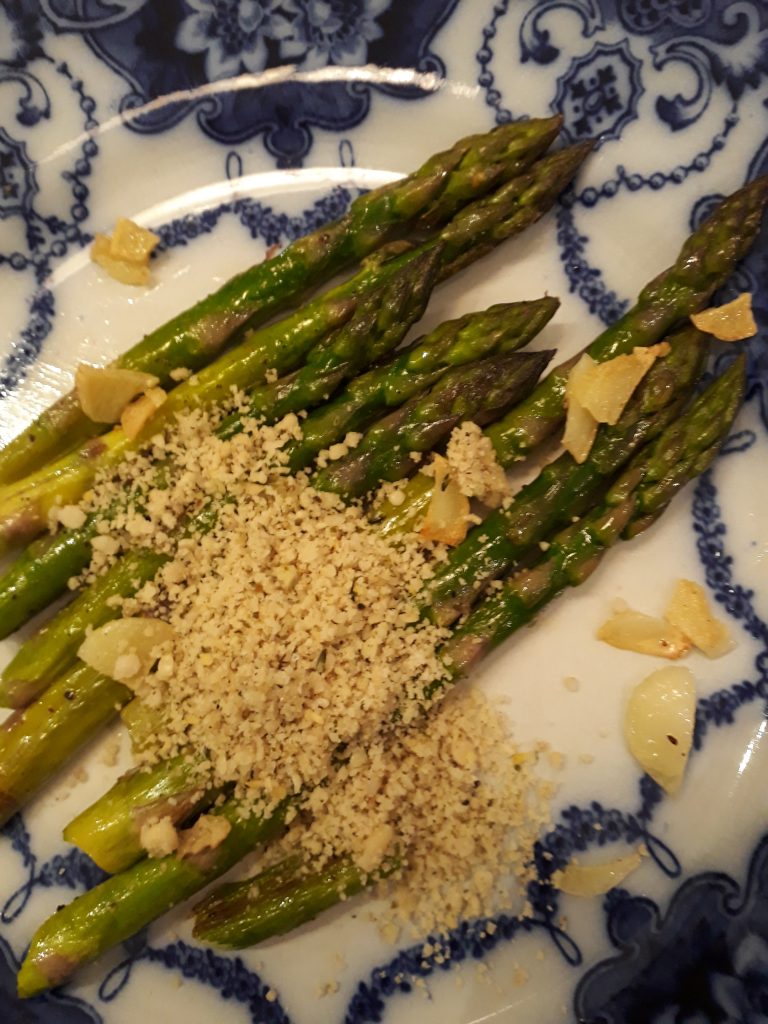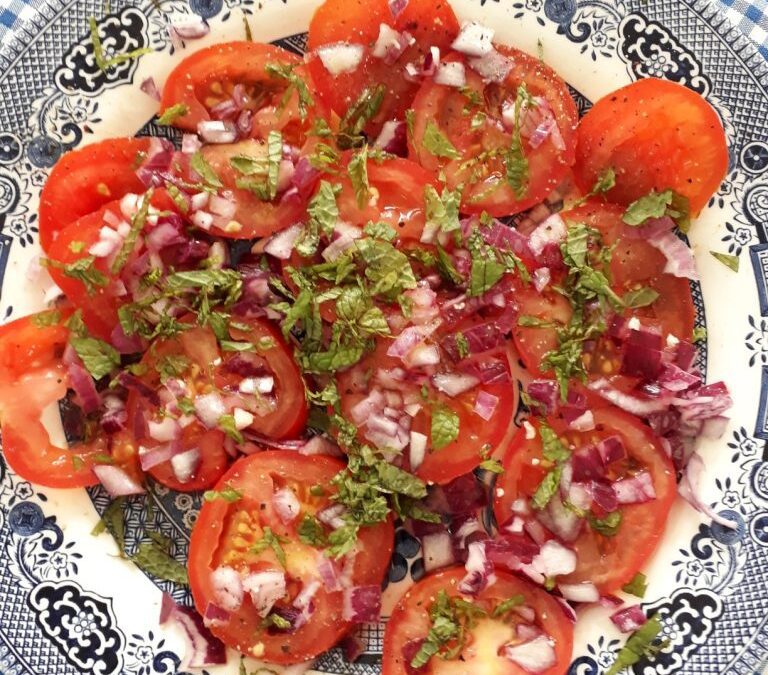
Sep 28, 2023 | Anna's Best Recipes, Main courses, Sides, starters, soups & snacks
Now Autumn’s here and with it some crazy storms I’ve rediscovered this high protein immune-supporting soup that’s a bowl full of sunshine. To make it into a complete meal add a cupful of cooked greens per person at the end (a bag of baby spinach would do). If you want to gain weight, add some extra carbs such as wholemeal gluten-free bread or leftover cooked rice (reheat well in the soup). If you eat gluten) some 100% rye or wholemeal sourdough. This soup freezes well too.
For 4
Note: You can save yourself effort chop all veg and spices only roughly if you’re going to blend the soup later on.
1 very large onion or 2 medium chopped onions
2 large sticks celery, sliced
2 large carrots (about 300g), sliced
2 heaped tbs (tablespoons) finely grated fresh ginger
1-2 rounded tbs ghee or virgin coconut oil (if you have an inflamed gut, ghee is best).
3 cloves garlic, crushed
Heaped teaspoon turmeric powder
Heaped teaspoon coriander powder
1/2 level tsp ground cardamom powder if you have it
500ml carton of passata (sieved tomatoes) or a 400g can chopped tomatoes
750ml filtered water or leftover vegetable cooking water (e.g. from steaming veg)
250g (mug and a quarter) dried red lentils
1 heaped tsp health store additive-free vegetable stock powder (for the SC Diet use Dr Coys Organic Vegetable Bouillon)
Freshly ground black pepper
1. Heat a large heavy-bottomed saucepan with lid on a medium heat for a minute. Add ghee/oil, onion, celery, carrots, ginger and a small splash of water, cover with a lid and sweat for 10 minutes.
2. Add garlic, turmeric and cardamom if you have it, stir for a minute before adding passata/tinned tomatoes and water.
3.Give everything a stir then add the lentils so they sit on top (otherwise during cooking they stick to the bottom). If the lentils are not entirely submerged in liquid, add a bit more water or stock.
4. Boil for 15-20 mins for 20 mins/until lentils and veg are soft. Only stir the lentils gently at the very top if they are stuck together, otherwise leave them alone.
5. Mix the veg stock powder into a little water and add to the soup AFTER the the lentils are soft (otherwise salt makes the lentils touch).
4. If you want a smooth soup now give it a whizz with a stick blender.
5 reasons this is good for you:
Lentils and onions contain prebiotic fibre. This feeds friendly bacteria you need for healthy digestive system and immunity.
Turmeric, ginger, garlic, coconut oil, cardamom and coriander reduce numbers of disease-causing bacteria/viruses in your gut.
Processed cooked tomatoes are the richest source of antioxidant lycopene to help ALL of you
Ghee contains butyric acid, a metabolite produced by friendly bowel bacteria to keep your gut and immune system tip-top.
Lentils are a rich and easy-to-digest source of protein which is essential for antibody production to protect against infection.

Sep 5, 2022 | Anna's Best Recipes, Sides, starters, soups & snacks
This is my all-time favourite potato salad. A far cry from the claggy, low-grade ones made with health-sabotaging refined oil. Amazingly, cold potatoes have very different health-giving properties from warm or hot. For the reason why, scroll to the bottom. Some people like to use waxy potatoes. Personally I prefer floury ones which partly break up. Serving size isn’t enormous as you’ll want to save space for masses of low carb veg and some quality protein to keep you fuller longer.
For 4
4 medium size potatoes (about 500g in all), scrubbed (no need to peel) and quartered
1/4 white/red onion, sliced thinly
Juice of 1/2 lemon
Large handful (3 tbs) chopped fresh parsley or dill
Freshly ground black pepper
Generous pinch salt
Liberal amounts of extra virgin olive oil
1. Boil the potatoes till cooked. Drain.
2. In a bowl combine hot potatoes, onion, 2 tbs extra virgin olive oil, salt, a few good grinds of black pepper.
3. If you like your onions not to have any “heat” add the lemon juice now.
4. Just before serving add the herbs and if you like, most extra virgin olive oil to taste.
Why this is good for you:
Cooked and cooled potatoes are a rich source of resistant starch. This magical starch feeds beneficial bacteria in your bowel that aid all aspects of your health. Resistant disappears if you reheat the potatoes and reappears when they are cold. Cooked, cooled rice is another good source of resistant starch. Herbs are a great source of antioxidants to calm inflammation and reduce the growth of unhelpful gut bacteria. Even a dessertspoon of cooked cooled rice or potatoes feeds friendly bacteria. Large amounts of high carb foods like grains, rice and potatoes are counter-productive as their high sugar levels promote overgrowths of unhelpful bugs. If you limit starchy carbs to no more than 1/4 your lunch and dinner plate you’ll be doing great!!

Jul 1, 2022 | Anna's Best Recipes, Dressings, rubs, spreads, sauces & more, Sides, starters, soups & snacks
There’s nothing like home-made hummus for flavour. It’s super-easy to do and if you like it, make a big batch and freeze some for the future.
1 mugful of cooked chickpeas (or haricot, cannellini, butter or broad beans) – keep some of the cooking water if you have cooked your own
OR
400g tin of no added sugar chickpeas, rinsed and drained
1½-3 tbsp olive oil (extra virgin)
2 large cloves garlic, crushed
Juice of ½ – 1 lemon
1 heaped dessertspoonful tahini (health stores/Asian shops. Raw tahini such as Carly’s brand is best)
Plenty of freshly ground black pepper
1 rounded tsp ground coriander
1 rounded tsp ground cumin
Generous pinch or two of Himalayan/Atlantic Sea Salt
Optional extras (see below)
- Blitz everything together in your food processor or mini food processor until mixed. You may need a bit more liquid (lemon juice or olive oil) to get everything mixing well.
- Add extra lemon juice/olive oil to taste. If the mix is too thick add a a bit of chickpea cooking water or plain water and blitz again.
Blitz in one or two of the following if you like:
- 2 tbsp chopped fresh coriander, parsley or chives,
- 3-4 tomatoes you have roasted or cooked under the grill till soft
- A teaspoon of spicy harissa paste (from ethnic shops) or ½ teasp chilli powder
- A teaspoon of sun dried tomato paste from the jar
- A teaspoon of black olive tapenade
- 2-3 roasted red peppers (available in jars from ethnic shops)
Tip:
Grinding your own cumin or coriander with a spice grinder gives a dramatically more flavoursome spice. This is because ground spices, when stored, lose some of their health-giving, aromatic oils. Always store your ground spices in an airtight container in a dark place.
Why this is good for you:
Most shop-bought hummus is made using cheap, refined (toxic) oils instead of the traditional extra virgin olive oil which is a superfood. It stands to reason that making your own is head and shoulders above anything else in quality and freshness.

Mar 31, 2022 | Anna's Best Recipes, Main courses, Sides, starters, soups & snacks
Just invented this last week from what we had in the fridge. It’s LOVELY with its blend of salty, smokey and fresh flavours. Lovely with a fresh mixed salad. Make sure to buy actual feta which is made from ewe (sheep) or goat milk. Do try to avoid the nasty pitted olives in black water available in supermarkets – they have almost no flavour and are only black because of black food dye. If you want to save, get your black olives in middle Eastern shops where they’re great value.
I don’t add the mint until just before serving as it goes limp quickly.
1 packet (around 200g) feta, cut in bite sized cubes as small as you like
1 large aubergine
Heaped teaspoon (or more) ground coriander
3 dsp extra virgin olive oil (EVOO)
1 dsp lemon juice or apple cider vinegar
Freshly ground black pepper
Handful un-pitted olives (ideally wrinkly dry black ones or kalamata)
Generous handful washed mint leaves
- Turn on grill to high.
- Slice an aubergine in 1cm (or a bit thinner) slices (disks or lengthways, whatever you prefer).
- Put aubergine slices on grill, brush with extra virgin olive oil (EVOO) and sprinkle with a little ground coriander. Grill till golden while you assemble the other ingredients. Then turn and repeat the process. Remove from heat and allow to cool slightly. Cut into bite size pieces or strips (I use a scissors to do this quickly).
- Into a large serving bowl put aubergine, olives, feta, EVOO, lemon juice/vinegar and a few generous grinds of black pepper and gently mix everything.
- Just before serving chop the mint. Sprinkle it over the top or mix it in.
Serve with:
Low carb: A big mixed salad dressed with my favourite dressing https://www.annacollins.ie/mediterranean-salad-dressing/
Medium carb: Salad + something starchy like wholemeal gluten-free bread or (for gluten eaters) a nice wholemeal rye sourdough.
Why this is good for you (provided you’re not dairy-sensitive!):
Goats and sheep’s cheese are high in protein and FAR more easy for humans to digest than cow. Modern (Jersey) cow’s milk contains A1 beta casein which is hard to digest. Goat and sheep milk contains 80% less of this problematic casein. Olives are a fermented food and contain beneficial bacteria to help your gut. Mint, like most herbs/spices, helps make your gut a hostile place for disease-causing bacteria and is also rich in polyphenols. Polyphenols are natural plant compounds shown to be anti-inflammatory, anti-oxidant and hugely supportive of your health – gut, brain, skin and more. What’s not to like?

Nov 30, 2021 | Anna's Best Recipes, Dressings, rubs, spreads, sauces & more, Sides, starters, soups & snacks
I love this! First tasted at Christmas in 1989 in Italy while I worked (briefly) as an au pair. So many interesting new foods and flavours. This one was a keeper. If you are a foodie you will definitely enjoy…
Makes 600ml stuffing (enough to stuff the body cavity and neck of a 1.8kg bird) with about 1 cup of leftovers which you can use to make my delicious stuffed mackerel fillets for another dinner. Another thing I like to do at Christmas is add a little bit of chicken bone broth to any stuffing that didn’t fit in the bird. Just enough to wet it and allow you to compact it. And then bake in a parcel in the oven at 180C for around 40 minutes. Give that similar gorgeous meaty flavour and moisture as you get when its been cooked in the bird.
260g cooked peeled chestnuts
or
130g dried peeled chestnuts , soaked overnight, then boiled til tender, drained
1 heaped dsp fresh thyme leaves (or a 1 level tsp dried, but fresh is much nicer)
1 rounded dsp chopped sage
2 heaped tbs chopped parsley
A few good grinds of black pepper
1/4 level tsp Himalayan or Atlantic sea salt
60g onion, finely chopped so it cooks properly (1/2 a medium onion)
Knob of butter (around the size of a walnut).
- Process or mash thoroughly the chestnuts until they resemble coarse breadcrumbs, tip into a bowl with the onion, herbs and seasoning.
- If using butter, melt it gently. Add your butter to the bowl and mix well. This stuffing can be stored for a couple of days in the fridge before using.
Why this is better for you:
Chestnuts are lower glycaemic index (lower sugar) than bread so are a much healthier alternative. They also contain potassium, which helps your body neutralise the effects of eating too much meat at Christmas. Fresh herbs are antioxidant, anti-inflammatory, support friendly gut bacteria and are anti-ageing – good news especially at Christmas!

Oct 3, 2021 | Anna's Best Recipes, Sides, starters, soups & snacks
I love this and I’ve made it so many times now I don’t need a recipe. Make it as cauliflower “steaks” or florets (a bit faster).
If you prefer an Indian vibe use a spice blend of 1 level tsp each of ground cumin, coriander and turmeric alongside the pepper and salt.
1 whole cauliflower, green leaves removed
1 heaped tsp ground sumac or sweet paprika
Freshly ground black pepper
Pink (Himalayan) salt
Extra virgin olive oil (about 2-3 tbs)
Roast cauliflower “steaks”
Preheat oven to 215c/200C fan
With the cauliflower standing on its stalk, slice it downwards into 1.5-2cm slices. You’ll get 4-5 good “steaks” and some shards.
Brush the roasting tin with extra virgin olive oil lay the cauliflower slices on top rubbing them around a bit to coat with the oil without breaking them up.
Brush the tops with olive oil, sprinkle with the sumac/paprika, lots of freshly ground black pepper and a generous pinch of salt.
Roast 15-20 mins at 200C. It’s done when the edges are starting to char.
Roast cauliflower florets
Take out central thick stalk from the cauliflower and break into small florets.
Put in the roasting dish, drizzle on extra virgin olive oil, sprinkle on your spices, pepper and salt and toss to coat.
Roast 10-15 mins at 220c/fan 200c.
Its done when the edges are starting to char.
If you feel like a fancier recipe with a delicious middle eastern dressing go to my blog post https://www.annacollins.ie/oven-roasted-cauliflower-green-bean-salad/

Mar 12, 2021 | Anna's Best Recipes, Sides, starters, soups & snacks
I LOVE this and it takes less than 10 minutes to cook. Have it as a side, or sprinkle with my vegan Parmesan (recipe on blog) or grated Parmesan and enjoy as a starter. Asparagus is contains prebiotic fibre, which feeds beneficial bacteria in your gut. You can make this even simpler if you want, by simply steaming the asparagus, then serving sprinkled with extra virgin olive oil etc. You can also steam asparagus, cut it up, cool and pimp up a lunchtime salad with it.
For 2
1 large bunch green asparagus
1 tbs extra virgin olive oil (EVOO)
Freshly ground black pepper
Optional: Parmesan or my vegan Parmesan to sprinkle
1. Rinse asparagus. Then snap off the thick fibrous ends (you can keep to make veg stock if you like).
2. Heat a frying pan on medium heat, add about 2 dsp EVOO (you don’t have to be exact), the same amount of water, asparagus spears and a good grind of pepper.
3. Cover with a lid or plate and cook for around 3-4 minutes until the colour changes to bright green and soft enough for your taste.
4. Divide between 2 plates and if you’re using as a starter, sprinkle with the Parmesan.

Feb 25, 2021 | Anna's Best Recipes, Dressings, rubs, spreads, sauces & more, Sides, starters, soups & snacks
If you’re dairy sensitive, one of the things you might miss is a sprinkle of Parmesan here and there. I LOVE this recipe for vegan Parmesan from Angela Elliot’s raw vegan cookbook “Alive in 5”. One of my favourite uses is on top of garlic braised asparagus. I soften 2-3 sliced cloves of garlic on a pan with a tbs extra virgin olive oil and same amount of water until softened. Then I add a bunch of asparagus, cover with a lid/plate, and gently cook for a few minutes until the asparagus has gone bright green. This means it’s done. Dish up and sprinkle with the “Parmesan”. Yum!!!
1 cup raw pine nuts (or half and half pine nuts and hemp hearts, which are more economical than pine nuts and give a creamy texture)
1/4 cup nutritional yeast powder/flakes
1/2 a level teaspoon of Himalayan salt
1 level tsp dried oregano.
Combine the nuts/hemp hearts, yeast, salt and oregano in a mini food processor or electric coffee grinder and pulse until it looks like breadcrumbs.
Keep this in an airtight glass jar in the fridge until you need it.

Jan 24, 2021 | Anna's Best Recipes, Main courses, Sides, starters, soups & snacks
This was a lovely curry my mother used to make from time to time. If you are making this a vegan dinner, its a great idea to bump up protein by serving with cooked quinoa and maybe adding some tinned chickpeas along with the courgettes. Otherwise you are very low on protein. I might also sometimes have this as a side with something fish/meat based and some cauliflower rice.
For 2:
1 medium onion, chopped
300g frozen or fresh shelled peas
1 large (around 350-400g) courgette, sliced
1 medium carrot, sliced thinly
1 dsp extra virgin coconut oil
1 dsp grated or finely chopped fresh ginger
1 tsp ground turmeric
½ level tsp chilli powder or cayenne (omit if you don’t like heat!)
1 dsp garam masala
Himalayan salt to taste
1 dsp lemon juice
1.Heat oil in saucepan on a medium heat, add a splash of water (about a tablespoon).
2.Add carrots, onion, ginger, turmeric, chilli powder if using and cover with a lid or a plate. Steam fry like this until carrots are softened and onions translucent. If everything starts to dry out and stick, add a splash more water.
3.Add peas and courgettes, cover and cook till soft, around 5 minutes usually. Tip: If you using frozen peas, rinsing them in hot water to thaw before adding to the pot will speed up the cooking.
Serve with one of these:
Grilled fish or chicken
A meat or fish curry
Cooked quinoa (not suitable for SC Diet): 1 cup quinoa, 2 cups boiling water, simmer covered till done – serves 2
Why this is good for you:
If you’ve been following me you’ll know by now that regularly eating a wide range of herbs, spices and different vegetables is important for your immune system, your mental health and for warding off tendencies to any sort of inflammatory condition. Turmeric and ginger in particular have thousands of peer reviewed research papers devoted to their various therapeutic actions. Part of their therapeutic action comes from their effects on your gut micro-organisms. They selectively discourage pathogenic bugs and encourage the good guys!!! Herbs and spices also stimulate your body to upregulate its OWN antioxidant defences. The antioxidant activity of these precious flavour bombs also helps reduce brain inflammation. If you are anxious, low or have any mental health issue your brain is inflamed. That’s why eating a (home made, with good quality oil like coconut) curry a couple of times a week and incorporating herbs and spices into every single day could really change your life. Happy eating….

Jul 6, 2020 | Anna's Best Recipes, Sides, starters, soups & snacks
Had this last night with some herb roast chicken and roasted cauliflower sprinkled with sumac. Fab. the recipe is courtesy of Domini Kemp and Patricia Daly’s Ketogenic Kitchen. If you are doing ketogenic diet and want to track carbs, protein etc, get the fatsecret app – even the free version is great.
For 4
4 large ripe beef tomatoes (1200g) 0r equivalent weight of vine tomatoes
Natural Himalayan/sea salt
Black pepper
1 medium red onion, finely diced
Small bunch of mint, finely chopped
1 large garlic clove, crushed
80ml extra virgin olive oil
Juice of 1 lemon or a splash of sherry vinegar
Macronutrients per serving: Net carbs 12.2g, protein 2.8g, fat 25.9g, fibre 4.1g
- Slice tomatoes into rounds, lay the slices out on a platter and sprinkle with salt.
- Leave for 20 minutes or more. This makes the tomatoes release their juices.
- Drain off juices and whisk together with the other ingredients.
- Add freshly ground black pepper to taste, and pour the dressing over the tomatoes. Serve.
Why this is good for you
Did you know that every vegetable, herb, spice and fruit contains a range of polyphenols (sorry, potatoes and bananas don’t contain many!). Polyphenols defend plants against threats e.g. viruses, fungi, bacteria, predators and UV rays. When you eat polyphenols they help strengthen all your body tissues and protect you against all chronic health conditions . Organic plants have more polyphenols because they are exposed to attack. They are not cocooned by pesticides and herbicides (herbicides kill soil bacteria). Attack stimulates plants to upregulate their defences – polyphenols. It’s a bit like when you train at the gym – you tear muscle fibres and the damage stimulates muscle to grow back bigger and stronger.
We absolutely need to be eating a wide range of plants including herbs and spices, over the course of every week. Tomatoes, mint, extra virgin olive oil, lemon juice, garlic all contain a big range of polyphenols. Tomatoes alone contain hydroxycinnamic acids, flavanones, flavonols, and anthocyanins, rutin and kaempferol-3-rutinoside and a lot of naringenin chalcone.
Raw extra virgin olive oil is a fantastic source of vitamin E. Vitamin E is anti-viral because it helps vitamin C work longer in your body. It also moisturises all your surfaces, outside and in. It is essential for the health of your heart, your skin, your brain, everything. Only VERY expensive vitamin E supplements contain the full range of vitamin E compounds. But if you eat many plants, a variety of raw nuts and seeds, lots of extra virgin olive oil and your digestive system is working perfectly you will be getting more vitamin E than most.
